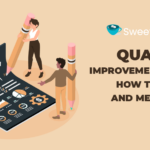The ROI of Employee Training and Development: How to Measure the Financial Benefits of Your Investments
Last Updated on February 29, 2024 by Owen McGab Enaohwo
Image Credit: eamesBot/Shutterstock.com
In a world where companies continuously compete for a competitive advantage, an organization’s most potent weapon is its people.
A vibrant and knowledgeable group can take a company to new heights. But how can one assess the actual benefit of the time and resources invested in developing a team? Truth is: You must know the return on investment (ROI) from the training and development of your employees.
ROI is more than a bunch of numbers. It also sheds light on the concrete and subtle benefits of training efforts. This article will examine the importance of measuring ROI, explore tried-and-true ways to compute it, and review common problems that arise during the process. So, sit back and start reading to get the inside story that could change how you work.
ROI of Employee Training and Development – Why is it Crucial?
To get a handle on the ROI of employee training and development, you must go beyond simple figures. And here’s the kicker: It’s all about achieving the best possible business results. Here are three vital reasons to put this first:
Smart Spending and Resource Planning
Measuring ROI gives organizations data-driven insights that help them allocate their budget and resources wisely. When every dollar counts, having a grasp of ROI guarantees that businesses distribute their money in ways that produce the most value.
Assessing Training Effectiveness
ROI turns data into measurable outputs. It’s critical to focus on the impact. Companies determine the actual worth of their training modules by performing an ROI analysis. This guarantees that employees acquire new skills and put those skills to excellent use.
Refining Future Training Programs
And lastly, ROI doesn’t only measure success. More than that, it highlights areas for growth. Monitoring ROI indicators lets businesses spot gaps in their training, developing more targeted future programs that are more efficient and with more significant impact.
Methods to Measure The ROI of Training Programs
For an organization to grow, it’s critical to figure out how training programs work. Hence, numerous businesses wonder how to measure ROI in training and development. Do we have your attention? Many turn to a blend of specialized methods and tools to obtain clear and actionable insights.
1. Use a Training ROI Tool
A training ROI calculator is an integral part of figuring out how much value training brings. This tool aids in calculating the training’s financial returns with its overall expenses. It works well with roles that have definite financial results.
For example, imagine spending $40,000 on training 30 call center employees for 100 days. After the program, one staff member can handle 30 calls per hour, an increase from the previous 25. This boost in productivity, amounting to a 30% growth, translates into improved service.
Assuming each call costs $1, the increased efficiency saves $5 per hour. That’s a finance savings of $40 per employee over an 8-hour workday. Therefore, the savings for the whole team add up to $1,200 every day, or $120,000 for 100 days. With these numbers, you can now use the formula above:
ROI% = ($120,000 – $40,000) / $40,000 x 100 = 200%
2. The Kirkpatrick Evaluation Method
The following method is the Kirkpatrick Evaluation introduced by Donald Kirkpatrick in the late 1950s. It was one of the first ways to evaluate training. This four-tiered approach goes into great detail about the training results, giving a complete picture of how well it works.
a. Reaction
This first level assesses how individuals respond immediately to the training. Were the employees engaged? Did they find the content relevant? It measures the perceived value of the activity by the participants gathered through questionnaires or feedback forms.
b. Learning
Here, the focus shifts to what the participants learned. Did the staff grasp the lessons? How well do they understand the covered topics? To check this, training facilitators often employ tests, quizzes, or hands-on demonstrations.
c. Behavior
At this point, assess if employees are using what they learned in their jobs. Are the participants putting their new skills into action? To determine this shift, use self-assessments, spot checks, and manager evaluations. Observations and chats often aid these behavioral changes after development programs.
d. Results
Lastly, this stage examines the training’s observable results, such as better productivity, higher sales, or decreased errors. This level assesses how the program directly affects the company’s main objectives.
3. The Phillips Training Assessment
Inspired by the Kirkpatrick Evaluation Model, Jack Phillips developed his framework in the early 2000s. One way this framework sets itself apart is by incorporating financial metrics.
This aspect gives organizations a better idea of the ROI of their training, ensuring a complete review and connecting program outcomes to financial effects. It goes one step further than the Kirkpatrick Evaluation Model and guarantees that the training reviews are related to actual business results.
a. Reaction
Similar to Kirkpatrick’s first stage, this level examines how employees feel and think after training. Were they pleased? Was the material valuable and interesting? Surveys conducted immediately after training and feedback forms record this sentiment.
b. Learning
This stage focuses on the participant’s gained knowledge or skills. How well did they grasp the new information? Quizzes, assessments, and practical demonstrations determine their depth of understanding.
c. Behavior
The main question is whether staff apply their new knowledge in the workplace. Are these new abilities visible in their daily tasks? Tools like performance reviews, interviews, and observations can help you understand these behavior changes.
d. Impact
For the fourth level, Jack Phillips termed it “Impact, suggesting a fuller assessment scope than mere “results.” This stage considers the benefits and possible drawbacks of training. At this point, you total all the training-related expenses and compare them to the resulting financial benefits.
e. ROI
Finally, the Phillips Model emphasizes the benefit of training programs and highlights ROI uniquely. This level converts tangible results into monetary figures by weighing the financial benefits of training against the costs associated with it. Thus, it provides a transparent framework through which companies may assess the value of their programs.
The Challenges of Measuring ROI of Employee Training and Development
While calculating ROI delivers valuable insights, managing its obstacles is vital. According to a recent study, less than 16% of organizations, regardless of learning type, successfully track learning measures, from satisfaction and participation to knowledge application and business benefits.
Below you’ll find common problems encountered in computing training ROI:
- Qualitative Data Gathering Issues: Gathering non-numerical insights is challenging, particularly when turning this information into measurable metrics. Despite the rich qualitative data, it often needs nuanced methods to guarantee it’s correct and valid.
- Unclear Research Focus: Data analysis becomes challenging when businesses lack well-defined goals or clear performance standards. Questions arise around targeted completion rates, expected evaluation scores, and how to assess the real-world impact of new abilities.
- Real-Time Data Obstacles: As training starts, it’s critical to gather relevant analytics. But sometimes, after program completion, companies need different data to determine how well it worked.
For example, after a counseling course, despite data showing all staff attended, it’s clear not all of them thoroughly grasped the topic. Much like when people ask, “What can you do with a psychology degree?” It underscores the need for clarity and direction.
Surveying employees after training takes up time and also risks erroneous feedback owing to memory lapses.
Reflecting on Training Investments
Employee training and development are critical to staff progress and overall company performance. But here’s the thing: Pinpointing the exact ROI can be challenging, but the rich insights and learning gained are pure gold.
Investing in training is only the tip of the iceberg for organizations everywhere. When you truly understand how your investment paid off, the magic happens. So, take the stage and make every training session more powerful rather than observing from the sidelines.
About The Author
Natasha is a content marketing specialist who thinks it’s kind of fun creating content marketing strategies for SaaS businesses. In her free time, she likes spending time watching Netflix.










Leave a Reply